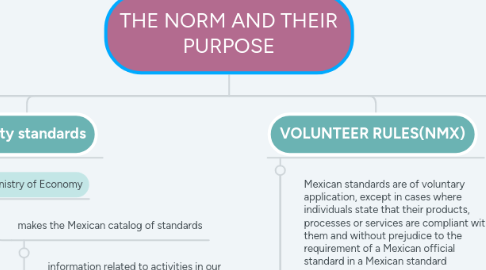
1. EVOLUTION
1.1. International standardization arise in 1906 with the created of International Electrotechnical Committee (IEC)
1.2. In 1926 the International Standardization Associates was created. But it was dissolved in 1942 because of the threat of war in Europe
1.3. 14th October 1948 was created the International Organization for Standardization (ISO).
2. ISO
2.1. Find the standardization of product and safety standards for international companies or organizations.
2.2. According to the ISO 9000:2000, quality are a set of elements to satisfy special needs.
2.2.1. The quality have to respond the questions: What, Why, Where
2.3. Norma TS
2.3.1. Related standards
2.4. ISO 14000: concept and application
2.4.1. ISO 18000
3. Norms
3.1. The norm was a rule that should be followed or adjusted to a behavior.
3.2. NORMALIZE
3.2.1. Basic principles
3.2.1.1. Representativeness
3.2.1.2. Consensus
3.2.1.3. Public consultation
3.2.1.4. Upgrade
3.3. Types of standards
3.3.1. Company Standard
3.3.2. norms of branches or associations
3.3.3. national standards
3.3.4. international regional standards
3.3.5. International standards
3.3.6. because of the way they are applied: mandatory and voluntary
3.4. National reference standards
3.4.1. Official Mexican standards
4. Quality standards
4.1. Ministry of Economy
4.1.1. makes the Mexican catalog of standards
4.1.1.1. information related to activities in our country in the areas of metrolay, national and international standardization and conformity assessment, quality and promotion are found
4.1.1.1.1. Secretary of Health
4.1.1.1.2. SAGARPA
4.1.1.1.3. SEMARNAT
4.1.1.1.4. Communications and Transportation Secretary
5. VOLUNTEER RULES(NMX)
5.1. Mexican standards are of voluntary application, except in cases where individuals state that their products, processes or services are compliant with them and without prejudice to the requirement of a Mexican official standard in a Mexican standard enforcement for certain purposes
5.2. Metrology
5.2.1. It deals with the study and application of all the means of its own for the measurement of magnitudes
5.2.1.1. Objetive
5.2.1.1.1. Definition of accepted international units of measure
5.2.1.1.2. Performing units of measurement by scientific methods
5.2.1.1.3. Establishing traceability chains, determining and documenting the value and accuracy of a measurement
5.2.2. Profits
5.2.2.1. Promotes the development of a harmonized system of measures, analyses, accurate tests, necessary to make the industry competitive
5.2.2.2. It provides the industry with the necessary tools of measures for the research and development of particular fields, and to better define and control the quality of
5.2.2.3. products
5.2.2.4. Perfect methods and means of measurement
5.2.2.5. Facilits the exchange of scientific and technical information
5.2.2.6. It enables greater international standardization of products in gender
5.3. CENAM
6. International Standards: requirements and their application
6.1. ISO 9000:2000
6.1.1. REQUIREMENTS OF THE STANDARD
6.1.1.1. Quality Management System
6.1.1.2. General requirements
6.1.1.3. Generalities
6.1.1.4. Document Control
6.1.1.5. Control
6.1.1.6. Control of
6.1.1.7. Management of Address
6.1.1.8. Address Commitment
6.1.1.9. Customer Approach
6.1.1.10. Quality Policy
6.1.1.11. Planning

